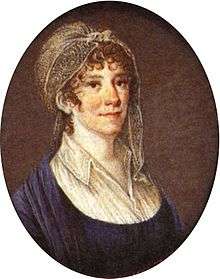Therese Huber

Therese Huber (7 May 1764 – 15 June 1829) was a German author. She was one of the so-called Universitätsmamsellen, a group of five academically active women during the 18th-and 19th century, daughters of academics on Göttingen University, alongside Meta Forkel-Liebeskind, Caroline Schelling, Philippine Engelhard, and Dorothea Schlözer.
Life

Therese Huber was born Marie Therese Heyne in Göttingen as daughter of the influential classical philologist Christian Gottlob Heyne. She married traveller and ethnologist Georg Forster in 1785. They lived in Wilno 1785–1787 and in Göttingen and Mainz 1788–1792 and had three children, but an unhappy marriage. After Forster had left Mainz for Paris as representative of the Mainz Republic, she and her lover Ludwig Ferdinand Huber, who had been living with the Forsters in Mainz, moved to Neuchâtel, living under difficult conditions there. She and Forster met for the last time in 1793, when he agreed to a divorce. However, Forster died soon after, and she married her lover. After his 1804 death, she moved in with her daughter in Ulm. Huber died in 1829 in Augsburg. The most notable of her ten children, six of which survived, was social reformer Victor Aimé Huber.
Works
Huber's main work consists of novels, novellas, and travel reports, at first published under her husband Ludwig's name. However, she was also working as editor of the Morgenblatt für gebildete Stände (Morning paper for the educated classes), as translator, and as essayist. Furthermore, she wrote over 4500 letters to many important contemporaries, about a wide range of topics. Later in her life, Huber edited the works and letters of both of her husbands. Her novel, Abentheuer auf einer Reise nach Neu-Holland [Adventures on a Voyage to New Holland] was serialized in the 1793-1794 issues of the German women’s magazine, Flora: part of the tale was set in Norfolk Island, which thus made its first appearance in a work of fiction. Georg Forster had been one of the party of the first Europeans to ever to set foot on Norfolk Island when it was discovered in October 1774 during Cook’s second voyage, and Therese had drawn on his description of it in his Reise um die Welt.[1]
Publications
(in German) Therese Huber's published works as cited by An Encyclopedia of Continental Women Writers.[2]
- Emilie von Varmont. Eine Geschichte in Briefen, 1794.
- Der Trostlose, comedy, 1794.
- Drei Weiber, 1795.
- Adele von Senange, 1795.
- Die Familie Seeldorf. Eine Geschichte, 1795.
- Luise. Ein Beitrag zur Geschichte der Konvenienz, 1796.
- Erzählungen 3 volumes, 1801-1802.
- Bemerkungen über Holland, 1811.
- Hannah, der Herrenhuterin Deborah Findling, 1821.
- Jugendmuth, 1824.
- Ellen Percy, oder Erziehungdurch Schicksale, 1827.
- Die Ehelosen, 1829.
- Erzählungen 6 volumes, 1830-1833.
- Die Weihe der Jungfrau bei dem Eintritt in die größere Welt, 1831.
- Die Geschichte des Cevennenn-Kriegs, 1834.
Other Publications
- Abentheuer auf einer Reise nach Neu-Holland. "Teutschlands Töchtern geweiht", Tübingen 1793; English translation by Rodney Livingstone, Adventures on a Journey to New Holland, edited by Leslie Bodi, Melbourne 1966.
- L. F. Hubers sämtliche Werke seit dem Jahr 1802, nebst seiner Biographie. Bd. 1–2. Tübingen 1806–10, +Fortsetzungen 1819.
- Johann Georg Forsters Briefwechsel. Nebst einigen Nachrichten von seinem Leben (2 Bände), Leipzig 1829.
References
- ↑ Flora: Teutschlands Töchtern geweiht von Freunden und Freundinnen des schönen Geschlechts, 4 (1793) 241-74; 1 (1794) 7-43, 209-75; cited in Robert J. King, "Norfolk Island: Phantasy and Reality, 1770-1814", The Great Circle (Journal of the Australian Association for Maritime History) vol.25, no.2, 2003, pp.20-41.
- ↑ Wilson, Katharina M. (1991). An Encyclopedia of Continental Women Writers. New York and London: Garland Publishing, Inc.
- Leslie Bodi: "Adventures on a Journey to New Holland" and "The Lonely Deathbed". Two novels of Therese Huber as documents of their time. Introduction to the English edition of these novels, Melbourne 1966. Also in Literatur, Politik, Identität — Literature, Politics, Cultural Identity. Österreichische und internationale Literaturprozesse vol. 18, ed. by Herbert Arlt, Röhrig Universitätsverlag, St. Ingbert 2002.
- Sabine Dorothea Jordan: 'Ludwig Ferdinand Huber(1764–1804). His Life and Works.' (Stuttgarter Arbeiten zur Germanistik, No.57). Stuttgart: Akademischer Verlag Hans-Dieter Heinz, 1978.
External links
- Therese Huber in the German National Library catalogue
- Eine kurze Biografie
- Eine ausführliche Biografie
- Die "Urmutter der Journalistinnen"
- Die Briefausgabe Therese Huber (3 von 9 Bänden).
- Carola Hilmes: Georg Forster und Therese Huber: Eine Ehe in Briefen
- A short bio
- A short Digital library of her writings